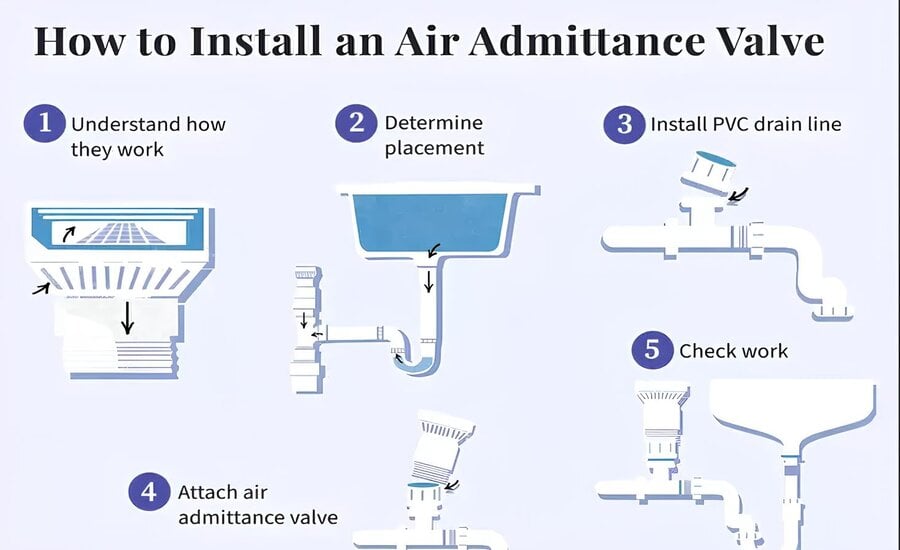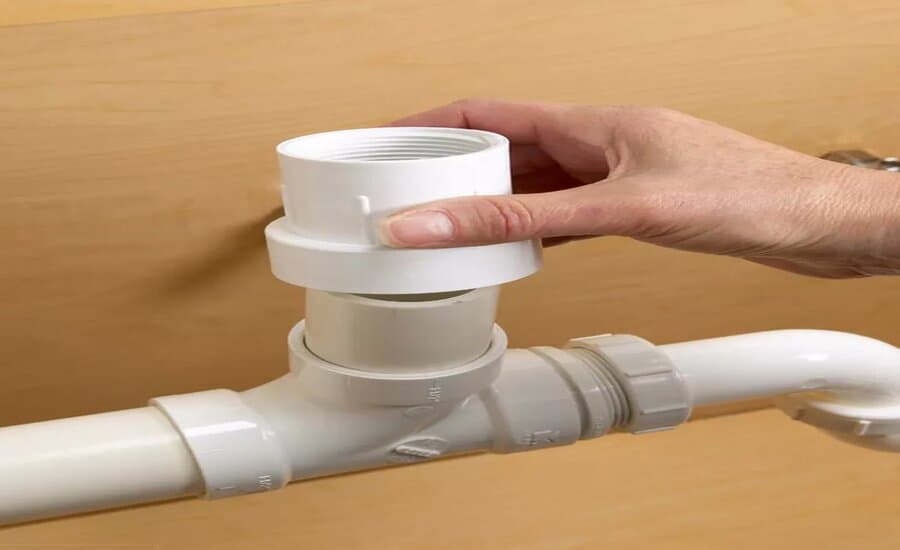Do you know how the air admittance valve works? When there is low pressure in the pipes because of water flow, AAVs allow air to enter the plumbing system. Gravity closes the vent terminal when system pressure balances (indicating no water is flowing). It keeps sewage gases from entering a structure.
This guide explains how air admittance valves work. It covers AAVs, why we need them, and how to install one to fix a slow-draining sink. Ultimately, we will learn the essential things to consider before buying, such as its height.

What Is an Air Admittance Valve?
Air admittance valve diagram. It allows air to enter your drain as the water disappears. Venting is critical for any plumbing system.
Air admittance valves have alternative names, such as drug valves, cheater valves, study air admittance valves, or mini vents. A locally installed one-way mechanical valve is at the location of the plumbing fixture. An admittance valve is a type of valve that maintains a seal while permitting air to enter or escape. The purpose of this is to regulate the internal pressure of a vessel.
Why Air Admittance Valve Is Necessary?
Utilize a venting system unless you choose sewage gases to enter your residence through positively pressurized plumbing. Moreover, AAVs are capable of completing their task.
Also, they balance the air pressure within your pipe. It prevents sewage gases from entering your living space and allows proper drainage.
How Do Air Admittance Valves (AAVs) Work?

How do air admittance valves (AAVss) work: a schematic representation of a traditional vented house and AAV vented house.
An ingenious mechanism operated by negative pressure activates an air admittance valve. The valve opens in response to negative pressure, permitting air to enter the pipe. Once the pressure balance is reestablished, the valve closes. It also allows for the intake of air while preventing the entry of unpleasant odors into the house.
Air admittance valves incorporate rubber seals. It aids in the formation of a complete seal. Thus, it enhances the valve’s performance and prevents odors from escaping from minute spaces.
We install air admittance valves using a push-fit joint. It enables the installation of pipelines and sockets without requiring any instruments. Push-fit joints use a rubber seal to create an airtight and closed connection.
Additionally, solvent weld joints are available for buy. Permanent hermetic and impermeable bonds are produced through a chemical reaction when a solvent is applied.
When Do You Need An Air Admittance Valve?
- To minimize roof penetration
AAVs are open and close with the DWV system, so no extra roof holes are needed. Aesthetic and design considerations aside, many householders avoid venting through the roof line. Furthermore, a diminished number of roof penetrations can gradually minimize the chance of leakage.
- To save money
Using an AAV venting system in new construction is more cost-effective than installing a vent conduit. This is because it requires less work and materials.
Before installing an AAV in your plumbing system, check with local authorities to ensure they allow it for your needs.
- When you cannot connect to an existing ventilation system
AAVs are a great option instead of stack vents. AAVs are an excellent alternative to stack vents. People use them to connect;
- island sinks, bathroom assemblies, home remodels
This is useful when connecting to an existing venting system is complex. Thus, AAVs provide greater versatility to householders in arranging their plumbing fixtures.
How To Install AAV To Fix a Slow-Draining Sink

Steps to install air admittance-valve
Running new vent lines can be difficult when a structural element. It obstructs access to the existing drain-waste-vent system. This often happens during plumbing renovations. Minor obstacles should not prevent you from completing the kitchen renovation of your dreams.
The use of an air admittance valve (AAV) is one solution. These gravity-operated valves open in response to the negative pressure. It is generated by discharging water to allow air. The valve is then sealed by gravity, preventing sewer gases from entering the room.
AAVs can handle various vent lines, depending on the vent capacity and the valve in question. Local codes prohibit the use of air admittance valves (AAVs) as a substitute for ventilation.
Consult with your local building inspection office before installing an AAV. Learn about air admittance valves (AAVs) and how to install them to save money and time.
See also What Is a Thermostatic Valve
What You Require to Install It?
Tools/ Equipment:
- Felt-tip marker
- PVC saw or backsaw
- Deburring tool
- Miter box or power miter saw
Require Material:
- P-trap
- Air admittance valve
- Drain pipe
- Cement and primer for size and type of pipe
Steps:
Step 1: Understand Air Admittance Valves Working Mechanism
Knowing how air admittance valves work is essential before installing one. The mechanism of operation of air admittance valves is gravity. The waste and water flowing down the conduit produce negative air pressure in a drain line. The inflow of air into the sealing gasket, caused by the negative pressure, helps the unrestricted drainage of the waste.
Once you cut off the negative pressure, the sealing gasket readjusts to its original position. Previous versions of this device operated via springs. Although still available, these devices are unreliable and fail to keep up with building codes.
Step 2: Finding Placement

In most cases, the junction of the discharge line and the P-trap of a fixture positions air admittance valves. One sanitary toilet tee affixes them, while the other leg directs toward the receptacle. Local regulations and the manufacturer’s guidelines require positioning the device.
Step 3: Install PVC Drain Line
The PVC drain line, sanitary coupling, and P-trap for the sink should be installed. The tee is attached to the AAV using the proper coupling, which may be threaded or bonded. Check local codes and the manufacturer’s instructions. It helps to determine the correct AAV height above the drain.
Step 4: Air Admittance Valve Attachment

How air admittance valve works; valve attachment
Fix the AAV with adhesive or screws, depending on the sort of fitting. For further help, see the instructions provided by the aav manufacturer.
Step 5: Check Work
This should be the complete installation, depending on the AAV model and local codes. Under-sink obstructions must be eliminated from AAV installations, performing vertically.
How To Notify If An Air Admittance Valve Is Working
If you take off the valve and shake the AV valve, you should be able to hear the diaphragm rattling if you shake it hard enough. The air admittance valves may not have worked if you don’t hear any noise. The open position of an AAV has also been compromised if sewer gas can be detected by odor.
Can You Use Air Admittance Valves Outside?
Installing air admittance valves from the outside is possible but not exceedingly common. You only do it when the soil pipe is too close to an open window.
Open pipe exits must be placed no less than three meters away from a window that can be opened. However, you are installing an air-admittance valve closer than this. When installing an outdoor plumbing drain vent valve, choose a model that can withstand frost and other harsh weather conditions.
What Is the Installation Height of the Air Admittance Valve?
At what height should you install the air admittance valve? Maintaining a minimum height of 200mm above any water entry point is imperative.
So, if your soil pipe is to be run, the drug valve or air admittance valve must be installed above the highest connection from any toilet, bath, or sink linked to the soil pipe. The installation occurs at the very terminus of the soil conduit. If necessary, connect them in line via a soil pipe junction.
Typically, the air admittance valve is installed in the loft or is enclosed within the structure. To conceal it, it was installed in ventilation cabinets. The valve must enable air to enter; thus, it must be installed in an area with access to air to ease ventilation. An extra factor is the installation location accessible in case maintenance is required.
Can’t we use an air-admittance valve under the sink?
We have been explaining how to install an air admittance valve under the sink. The typical size of this form of AAV for discharge pipes is 32mm instead of 110mm. A more diminutive in size, this valve is designed to decrease the pressure within the waste pipe.
Its purpose is to prevent the release of gases and gurgling sounds from kitchen appliances. It is sometimes when the water from the sink does not flow out rapidly enough.
Things You Should Know Before Buying Air Admittance Valve
- Air admittance valve location
It would be best to place an AAV within the vent’s maximum developed length. It should be 4 inches above the outer drain, 6 inches above the insulation, and at a 15-degree angle. We shouldn’t cover AAVs and place them where air can reach the valve. Additionally, they must be accessible in case replacement becomes necessary.
- Size
The Drainage Fixture Unit load of the fixture will help you determine what size AAV you need. DFUs measure an AAV’s venting ability. A higher DFU rating on the valve allows more air to flow into the drain-waste-vent (DWV) system.
DFU loads are determined for plumbing devices based on the flow rate, the operation length, and the time between operations.
Calculate all the fixtures that require venting and determine the total DFU load to ensure proper venting. Then, choose the right AAV for the task. Getting the AAV size right is crucial because the plumbing system won’t function properly if it is too small.
AAVs usually come with adapter connections that are 1 ½”, 2″, 3″, and 4″. The air pipe’s width determines this adapter’s size. Mostly, a vent should be half the diameter of the pipe it serves (check your local codes for exact vent size suggestions). Generally, a vent should be half the width of the pipe it serves.
- Manufacturer requirements and local code
To use an AAV, check if your municipality and the AAV manufacturer allow it. You can review their codes and specifications before going to the store. If you cannot use an AAV, use the home’s regular venting system. This will enable the sending of air to the fixture or drainage system.
- Pipe material
For connection reasons, you check what pipe material you will use to join the AAV adapter. It would be best if you used AAVs with PVC connectors with PVC pipes. It would be best to use AAVs with ABS connectors for ABS pipes.
To Wrap Up with How Air Admittance Valve Work
In this article on how the air admittance valve works, we recommend contacting a plumber to assess the situation if you feel that the ventilation in your home is not functioning correctly. Toxic and foul-smelling releases in the household are no fun matter.
You could also try installing an AAV if you are ready to undertake the challenge and possess the necessary expertise.
Additionally, consult your local building department before installing an air admittance valve into your plumbing system. It will help to ensure that an AAV in your home complies with all applicable regulations.
